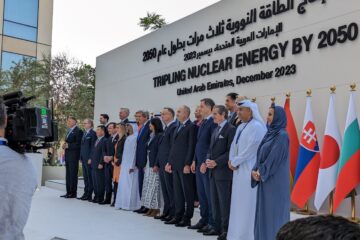The nuclear industry approach to managing waste is a model for all
This month, as we continue our short series on energy economics, our focus is the nuclear industry’s commitment to safely managing its wastes. More specifically how this commitment ensures the cost of managing waste is included in nuclear power economics and how funds are set aside to pay for it.
As we have noted before, almost every article on nuclear energy, including the supportive ones will comment on the enduring problem of nuclear waste. This waste “problem” is often presented as insurmountable. Yet, the world is full of toxic wastes from human activities. Everything from mining to chemical processes to simple garbage thrown out from everyday household products are cause for concern.

Caption: If all your energy was produced from nuclear power for your entire life, the resulting waste would fit into a pop can Source: iStockPhoto.com
Every form of electricity generation creates waste products. Even renewable sources of electricity like solar and wind contain toxic substances in their panels and turbines and result in a need to manage their waste. The International Renewable Energy Agency (IRENA)’s official projections assert that “large amounts of annual waste are anticipated by the early 2030s” and could total 78 million tonnes by the year 2050.
You would be led to believe that nuclear waste is the worst of the worst (In this case waste is referring the used fuel coming out of the reactor). But is it? The reality is nuclear waste is in a solid form, the volumes are relatively small, are easily contained and well managed. There has never been a fatality due to the storage of nuclear waste.
From an economic perspective, it has long been required by regulation to accommodate the cost of managing waste and the cost of decommissioning the nuclear plant at its end of life into the cost of electricity production. In other words, every operating plant is required to charge a fee for every MWh produced to create a fund to pay for waste management. In most jurisdictions this fund is required to be segregated and funded (rather than just an item on the owner’s balance sheet) so that in case the owner is no longer solvent when the plant reaches end of life, the fund will be there to pay for waste management and decommissioning.
In the International Energy Agency’s (IEA) Projected Cost of Electricity report, the assumed cost of managing used fuel waste is $2.33 / MWh. The fee for decommissioning is even smaller in the $0.1 / MWh range. This compares to about $7.00 / MWh as the fuel cost and a total Levelized Cost of Electricity (LCOE) of about $70 / MWh (or 7 cents/kWh). Therefore, accounting for the cost of managing waste and decommissioning requires adding about 3% to the cost of electricity throughout the unit’s operating life. One reason this is relatively small is once again due to the high energy density of nuclear fuel. Or in other words, a very small amount of fuel produces a very large amount of energy. Each jurisdiction has its own method for calculating the amount of money to put aside. Here in Canada, the cost to manage waste is updated every five years and then the amount collected in the cost of electricity is adjusted to ensure the fund remains adequate to pay for final disposal.
If only other forms of energy managed their wastes so responsibly. We have issues in western Canada with oil rigs abandoned with no one to clean them up. Coal burning pollutes with much of its waste being airborne particulates that cause significant harm to our health. And as solar panels and wind turbines reach their end of lives there is going to be a large volume of waste that will need to be safely managed.
The nuclear industry has always focused its efforts on ensuring it provides reliable economic electricity while minimizing any impact to the environment. This approach has the industry taking full responsibility to manage its waste. Rather than being concerned about nuclear waste, this model of ensuring that fully funded plans are in place to safely manage waste should be a standard applied to all forms of energy production. This is the path to a sustainable future.
The war in Ukraine has raised concerns about global energy security as well as the safety of nuclear reactors under siege. On the one hand, the safety concerns have stoked fear; and on the other, energy security issues support discussions of increasing the use of nuclear power as an option to reduce dependence upon imported fossil fuels. We will comment on these issues in future posts.





2 Comments
Sharon Charnesky · March 28, 2022 at 12:22 pm
How interesting that the nuclear industry is responsible by government to account for waste but the oil industry has been allowed to run “”free””.
Nardia Ali · March 28, 2022 at 1:41 pm
I wish the Canadian public could be better educated on nuclear and waste management. Thanks for doing this blog Milt.
Comments are closed.